The Baseball Card Scam
Insurance Fraud Costs Everyone
Fictionalized True Crime Story of Insurance Fraud from an Expert who explains why Insurance Fraud is a “Heads I Win, Tails You Lose” situation for Insurers. The story that follows are designed to help everyone Understand How Insurance Fraud in America is Costing Everyone who Buys Insurance Thousands of Dollars Every year and Why Insurance Fraud is Safer and More Profitable for the Perpetrators than any Other Crime.
The insurance industry, unintentionally, instructs its insureds how to successfully perpetrate insurance fraud. Insurers encourage fraud by:
decimating its professional claim staff by short-sighted cost cutting.
by selling insurance to persons unknown to the company or the broker.
by accepting the word of new applicants without a pre-risk survey.
by allowing threats of bad faith lawsuits to intimidate the company into a quick settlement.
Commercial property insurance has proven to be an excellent training ground for novice frauds. Baseball cards are collectibles with widely varying values depending on rarity and condition. The value of a collectible card is totally subjective and, as a result, difficult to insure.
Why A Retail Baseball Card Store Was an Invitation to Fraud
The husband and wife had failed in several tries to conduct a profitable retail business. They simultaneously closed their comic book store and opened a new business called Out In Left Field where they sold baseball cards in the 1980’s at the apex of the baseball card fad. They located in a new, strip shopping center, in a residential area of Fresno, California.
The store lease required Out In Left Field to maintain liability insurance for the landlord. Out In Left Field first tried to buy insurance from the captive agent of a major mutual insurance company. Because of their lack of experience in the baseball card business the agent’s mutual insurer would not accept the risk.
The agent then investigated the surplus lines market seeking insurance for the business. In that market he found an insurer willing to take the risk without a signed application. The husband and wife, at first, had only requested the liability policy required by their lease. The agent advised them that it would be in their best interest to have a business owners’ policy (BOP). The premium was relatively low and they, therefore, bought an all risk coverage with $50,000 limits of liability on their business personal property.
At no time, before the inception of the policy or after, did anyone ask the insureds for substantiation that Out In Left Field had an inventory of $50,000 in business personal property. No one asked for any documentation to show that Out In Left Field had ever performed a physical inventory. No one asked for any documentation that they had any business records that the insurer could rely upon at the time of loss. Only the local agent even visited their shop.
The insureds went to several baseball card shows and began purchasing an inventory of low value cards for between one and three dollars a card. They offered these for sale at retail price in their local Fresno showroom.
The earnings of Out In Left Field were no better than its predecessor, the comic book store. The insureds were considering closing their store down and walking away from their lease. They had no assets which their landlord could attach, even if he got a judgment against them.
Fortuitously, for the insureds, a burglar entered the premises, removed a portable radio, an adding machine, $50.00 in change from their cash register and a few baseball cards. The insureds reported the loss to their insurer.
A young adjuster, who had never been in a retail business in his life except as a customer, made first contact by telephone. He had no knowledge of the marketplace for baseball cards and no personal experience operating a business. In fact, he had just graduated from the insurer’s two week claims training class. The adjuster spoke briefly with the insureds and took a three minute recorded statement limited to the discovery of the burglary.
The adjuster mailed the insureds blank sheets to fill out listing all of the property claimed taken. He also asked for purchase invoices to support the ownership of the items in question.
The insureds, at the time of the burglary, were basically honest people. Their business was failing and the temptation provided to them by the young adjuster was too much to resist.
The insureds stayed up for three nights and prepared a list. It included not only the theft of the radio, the cash from the cash register, and the adding machine but also of fifty (50) prime, excellent condition, baseball cards and two hundred fifty (250) modern cards valued at $2.00 each. The descriptions and values came directly from a catalogue.
The list included a card of the year Henry Aaron broke the home run record and Mickey Mantle’s rookie year. It also included Roger Maris’ 61 home run year and Willie Mays’ rookie year.
Each card was valued by the insureds at more than $1500 each. They then changed the purchase invoices and added to the purchase price three numbers to the left of each invoice amount. The invoices thus appeared to verify the purchases of the cards they claimed stolen. The total amount of claimed loss exceeded their policy limits. They made Xerox copies of each of the invoices to give to the adjuster. The adjuster did not even bother looking at the originals. The adjuster did not, therefore, see that some of the invoices were written in different color ink. If the adjuster saw the original invoices, he would have seen the changes.
The adjuster was surprised when he received the claims forms. He did not expect such a large loss. He telephoned another retail baseball card store and learned that fifty baseball cards like those claimed stolen could easily be worth more than $50,000.
He did not know what to do. He spoke with his supervisor. The supervisor suggested an audit of the books and records of Out In Left Field by an accountant. The accountant, receiving the same forged documents, the adjuster had received found that the insureds’ calculations were correct. The accountant hired to audit the records of the insureds never looked at original documentation.
The supervisor, still wary of the claim, suggested an attorney conduct an examination under oath of the insureds. However, before the lawyer started the insured’s wife telephoned the adjuster to advise that, as the adjuster knew, her disabled husband’s only interest was Out In Left Field.
She explained that because of the delays in the payment of their claim and the time they had to spend with the accountant the insureds were unable to buy inventory. The insureds had sold nothing and could not pay their rent.
Her husband had become so depressed as a result of the delays of the adjuster that he had tried suicide. He was well, at the moment, she said and begged him to make the claim payment. The adjuster and the supervisor, with a minuscule investigation, and no facts to go on, decided to pay the policy limits as soon as possible.
The adjuster delivered a draft for the amount claimed the next day. A notice of nonrenewal of the policy followed.
The insureds took the money and paid their back rent. They bought some new clothes and a new car. With what was left they tried to buy additional inventory for the store. Business was still poor since they were inept at running a retail business.
They decided, since the claim was so easy the first time that they would get a new insurance policy. They called every insurance agency in Fresno until they found one who was willing to present their risk to an insurer. Out In Left Field’s owners knew, because they had first tried honesty that they could not reveal the prior loss. When they reported, the prior loss to a different broker insurance was refused. When they did not reveal the prior loss, they got a policy with $150,000 in limits. The insurer’s only office was in Nebraska.
The new insurer relied totally on the representations of the insureds in the application. They conducted no pre-risk survey. The broker filled in the application over the phone. The broker did not even bother visiting the store.
Out In Left Field was in business again. Two months into the policy, after it had sufficiently ripened and before the second payment on the premium finance agreement was due, the insureds reported a burglary. This time, the loss more than $150,000 in baseball cards.
Fortunately, for the insurer, it retained an experienced independent adjuster to investigate its loss. Checking the ISO All Claims Data Base, the adjuster for the new insurer learned of the first loss. With the authorization of the insureds he saw a complete copy of the first insurer’s claim file. The new insurer demanded examination under oath before an attorney.
As soon as the demand letter arrived at the insureds’ home, the wife called the lawyer and begged an immediate settlement since her husband, depressed by the delays of the insurer, tried suicide. She told counsel she was afraid that if the insurer did not pay quickly, he would be successful in his next try.
The attorney, having read the first insurer’s claim file and seen the same threat of suicide, had been forewarned. He advised his client to strengthen their resolve. He advised them not to succumb to the fear as had the first insurer. Counsel then informed the insured that to conclude the claim she and her husband must first appear for, and testify at, an examination under oath. The insurer also required they bring to the examination all original documents.
The insureds retained counsel on a contingency fee who had no knowledge of their fraud. The insureds produced what they said were all original documents supporting their claim.
Although the insurer’s counsel was not an expert, the documents appeared to be forgeries to counsel. He repeatedly questioned the insureds about the documents until he got clear answers. The insureds testified that they received each of the original documents from sellers. They testified that they had never modified or changed the documents in any way. They further testified that the records were the business records of Out In Left Field and had been prepared the normal course of its business. All of their testimony was false.
To establish his suspicion counsel forwarded the original documents to a questioned document expert. The expert advised that every document had been changed or modified in date, amount and description from the original. Further, each of the invoices was written by two separate people in two difference handwritings, using two different writing instruments. The insurer, faced with such damming evidence, and on the advice of its counsel, rescinded the policy. The grounds stated were the material misrepresentation of fact concerning prior losses in the application for insurance. The insurer, as an alternative reason, also denied the claim for fraud. Counsel for the insurers also provided counsel for the insureds a copy of the questioned documents expert’s report.
Counsel for the insured immediately withdrew representation. The insureds agreed to rescission of the policy to get the return of their premium.
The insureds appeared satisfied with the resolution. At the time of their examination under oath they appeared in the offices of counsel for the insurer wearing a cervical collar and back brace respectively. At the examination under oath, they informed the insurer’s counsel that they had just had a rear-end auto accident where their best friend and neighbor had accidentally rear-ended them.
Although one insurer escaped making payment to these frauds, two did not. The first, who provided the training paid $50,000 for a loss that was probably no more than $800.00. An auto insurer also found itself making payments for an automobile accident that seemed to be fictitious.
This type of loss will continue to occur as long as insurers fail to maintain adequately trained claims and underwriting staff. If insurers continue to accept insureds at face value without any pre-risk inspections or investigation this type of loss will multiply. Insurance agents and brokers will have their loss ratios increase logarithmically. Profits will fall because they did not inspect and control the risks they insure.
Adapted from my book, Insurance Fraud Costs Everyone Available as a Kindle Book and Available as a Paperback from Amazon.com.
(c) 2024 Barry Zalma & ClaimSchool, Inc.
Please tell your friends and colleagues about this blog and the videos and let them subscribe to the blog and the videos.
Subscribe to my substack at https://barryzalma.substack.com/publish/post/107007808
Go to Newsbreak.com https://www.newsbreak.com/@c/1653419?s=01
Go to X @bzalma; Go to the podcast Zalma On Insurance at https://podcasters.spotify.com/pod/show/barry-zalma/support; Go to Barry Zalma videos at Rumble.com at https://rumble.com/c/c-262921; Go to Barry Zalma on YouTube- https://www.youtube.com/channel/UCysiZklEtxZsSF9DfC0Expg; Go to the Insurance Claims Library – http://zalma.com/blog/insurance-claims-library.
-
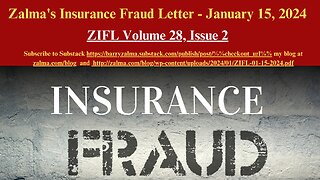 8:36
8:36
Barry Zalma, Inc. on Insurance Law
3 months agoZalma's Insurance Fraud Letter - January 15, 2024
178 -
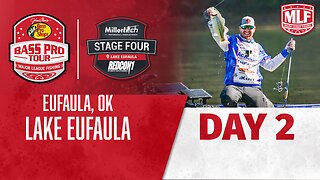 LIVE
LIVE
Major League Fishing
2 days agoBass Pro Tour LIVE - Stage Three - Day 2
27 watching -
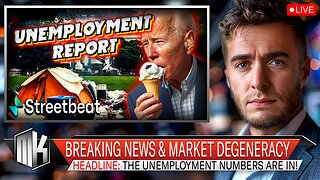 LIVE
LIVE
Matt Kohrs
7 hours agoCollege Chaos Persists, New Unemployment Report & Live Trading || The MK Show
1,227 watching -
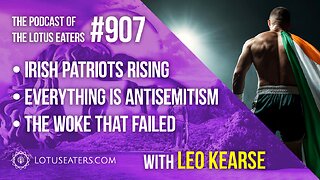 DVR
DVR
The Podcast of the Lotus Eaters
5 hours agoThe Podcast of the Lotus Eaters #907
9.84K8 -
 1:35:57
1:35:57
Crain and Company
3 hours agoGeorgia's Biggest SEC Threat in 2024 (Guest Tim Brando)
5.21K -
 17:02
17:02
PARAGRAPHIC
21 hours agoThe Oldest American Wheat is Coming Back | PARAGRAPHIC
9.38K12 -
7:02
Morgonn
22 hours agoDating Advice from COLLEGE STUDENTS??? Only Fans? Trans-Women? TELL ALL!!!
21.6K52 -
 22:59
22:59
JoBlo Originals
17 hours agoWhat Happened To Indiana Jones And The Dial Of Destiny?!
23.7K9 -
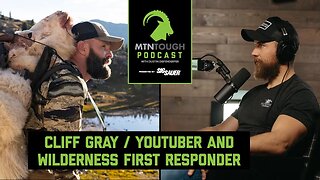 1:21:42
1:21:42
MTNTOUGH Fitness Lab
1 day agoCliff Gray: Escaping the 9 to 5 and Thriving in the Backcountry
25.6K1 -
 9:03
9:03
Adam Does Movies
1 day agoBoy Kills World Movie Review - Too Quirky For Mainstream Audiences?
30.6K1